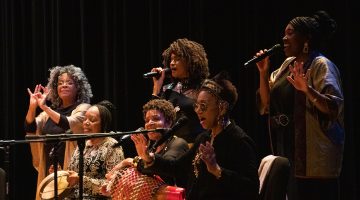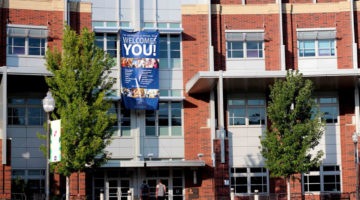
Students and faculty alike had the opportunity to witness literary history in the making at the Knowledge Center
last Tuesday when noted Shakespeare historians met to debate the authorship of “Double Falsehood.”
Photo illustration by Kaitlin Oki with photo courtesy of BOOKS18/Flickr.com
By Logan Miller
Professors Brean Hammond of the University of Nottingham and Tiffany Stern of Oxford University traded barbs during their debate last Tuesday “Double Falsehood: Long-lost Shakespeare Play or Diabolical Forgery?”
Hammond contacted Assistant Professor Ashley Marshall, a friend and a colleague, saying he would like to visit the University of Nevada, Reno after attending a conference at UCLA. Marshall met with Eric Rasmussen, renowned Shakespeare expert, professor and English department chair, and he suggested inviting Stern to debate the authorship of “Double Falsehood.”
A recitation of the prologue by Professor James Mardock and a scene reading by student actors Tara Brown and Wesley Gaines McNair was attached to the evenings proceedings.
The audience applauded their work, but through no fault of Brown, McNair and Mardock, who each brought chops suited to better productions, “Double Falsehood” falls flat as a play. Fortunately the controversy surrounding its authorship of the play was engaging, and the two scholars, playing to the packed audience at the Wells Fargo Auditorium, made their case for why this dud is thrilling.
Originally titled “Double Falshood; or, The Distrest Lovers,” the play resembles an episode from Cervantes’ “Don Quixote” titled “Cardenio,” but with different character names. It may have been based on a lost play by Shakespeare and his collaborator John Fletcher. Such a play was reportedly performed in 1613, a year after the first part of the novel was translated into English.
According to Stern, Lewis Theobald, a lawyer, editor and playwright working in London during the 18th century, wrote “Double Falsehood” in a bid to further his career by claiming he adapted his play from the original Shakespeare manuscript.
“He was trained as an attorney, but he was making his money as a hack writer,” Stern said. “He was principally making his money on pantomimes and harlequinades. He was a popular writer; he was not a posh guy.”
Theobald was interested in “Don Quixote” and in editing Shakespeare’s work regardless of the fact that honor was reserved for the poet Alexander Pope. He felt that Pope’s edits were dismal and that by using a creative editing process called emendation, he could produce better work. To discredit Pope and produce interest in his own edits, Theobald struck out on a public relations campaign.
During this time, Theobald announced the production of his own play, which he claimed was a modified version of an original Shakespeare manuscript. Contemporary critics from this time suggested that this play sounded more like Fletcher than Shakespeare. Additionally, some of Theobald’s emendations of Shakespeare suggest that he wasn’t able to reference the Bard’s handwriting during the editing process, a precaution he could have taken, if he had an original manuscript like he claimed.
Stern argued that Theobald could not have adapted an original Shakespeare manuscript, but that he might have had a restored one.
Hammond contended that Stern’s arguments amount to ad hominem attacks on Theobald as a writer of low-brow plays looking to further his own career and that he has, despite his inaccessible motives, the most emendations of Shakespeare surviving in modern editions.
“There are many people who would say, save Professor Rasmussen’s presence, [Theobald] might be the greatest editor of Shakespeare that ever lived,” Hammond said.
Hammond further argued that nowhere does Theobald suggest he has an original manuscript in Shakespeare’s handwriting and that he would have never done so, because he knew that there were only a few documents potentially penned by the Bard. Instead, he claims to have an edition written by John Downes, who, from 1662 to 1706, was a prompter for the Duke’s Company, an important Restoration theater company.
For Hammond, the play bears the hand of Fletcher and Shakespeare. He suggests that there is a direct line of transmission from the lost “Cardenio” to Theobald’s play. Being shorter than any Shakespeare play, it was probably heavily edited, but still contains the ruination of a woman and her restoration through marriage. This process occurs elsewhere in Shakespeare, but not in 18th century plays, where they never survive.
Furthermore, by utilizing stylometrics, a computational linguistic analysis of writing, scholars have concluded that Shakespeare and Fletcher wrote the bulk of the play. Recent research presented at UCLA using this method suggests that there was a zero percent chance that Theobald contributed substantially to the play, but that the chance of Shakespeare and Fletcher’s involvement was over 90 percent.
However, the veracity of such analyses is also a matter of debate. Stern suggested that an author could convincingly write in the manner of another writer.
“I think the problem is that he certainly forged a bit, and that he wanted to be taken for Shakespeare,” Stern said. “So if he had a manuscript, he would have also forged on top of it, presumably in a style not unlike Shakespeare and not unlike Fletcher, which makes the kind of stylometric analysis we do very difficult truly to work.”
At the end of the evening, a straw poll was suggested, but never taken, thus giving final credence to neither position.
If “Double Falsehood” is Shakespeare’s, it is one of his worst. This is enough for some writers to decry Hammond’s position as inexcusable. Among them is Ron Rosenbaum, author of “The Shakespeare Wars: Clashing Scholars, Public Fiascos, Palace Coups,” who described the The Arden Shakespeare edition of “Double Falsehood,” which Hammond edited, as a moneymaking scheme and affront to the Bard.
For Rosenbaum, the betrayal goes deeper than brand expansion.
“Arden does a disservice not just to Shakespeare but to all future innocents who come to the Shakespeare section of Barnes & Noble, say, and have the misfortune to pick up this piece of … fraudulence first,” Rosenbaum wrote in his article “The Double Falsehood of Double Falsehood” for Slate.com. “And having read it, never return for the real thing.”
However, if “Double Falsehood” is Shakespeare’s, it is not the only poorly regarded play in the corpus. “Titus Andronicus” has long been thus maligned.
The controversy elevates an otherwise mediocre play. The level of intrigue is on par with the best exhibited in the Bard’s work. If the play itself cannot entice readers on its own merits, this ongoing scholarship regarding its authorship could attract a new audience that may have never considered Shakespeare.











